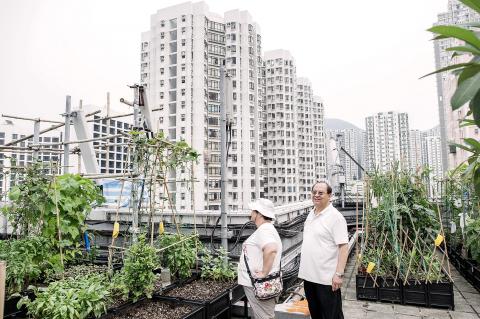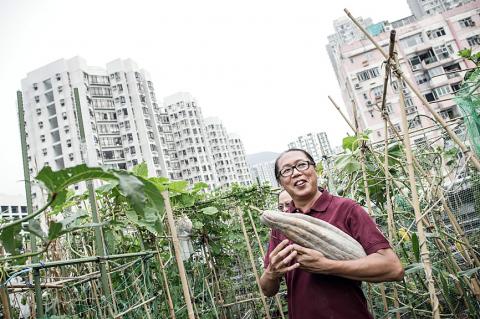On the rooftop of a tower block above the hustle and bustle of teeming Hong Kong, dedicated growers tend to their organic crops in a vegetable garden.
Against a backdrop of skyscrapers and jungle-clad hills, earth-filled boxes are spread out on the roof of the 14-story building, where a wide variety of produce — including cucumbers and potatoes — are cultivated.
It is one of several such sites that have sprung up in Hong Kong’s concrete jungle, as the appetite for organic produce grows and people seek ways to escape one of the most densely populated places on Earth.

Photo: AFP
“I am happier eating what I grow rather than food I buy from supermarkets,” said Melanie Lam, a 28-year-old nurse who comes to the “City Farm” in the Quarry Bay district of Hong Kong’s main island about twice a week.
“Compared to vegetables from the supermarket, vegetables that I plant are sweeter and fresher. It gives me a greater sense of satisfaction,” Lam said.
With most of the southern Chinese territory’s 7 million people living in tower blocks and land prices sky-high, unused roofs are some of the few places in the most heavily populated areas for budding vegetable gardeners.

Photo: AFP
The money-obsessed territory has been late to latch on to rooftop farming, which has been popular in cities such as London and New York for years.
While there are no official figures for the number of sites, as no license is needed to set one up, anecdotal evidence suggests their popularity is growing.
“I think urban farming is becoming more popular ... we have grown bigger in a short time,” sad Osbert Lam, the founder of City Farm, which has about 100 regular gardeners two years after opening.
There are 400 growing boxes on the 930m2 rooftop available for rent for HK$150 to HK$200 (US$20 to US$25) a month each.
TRANQUILITY
“People who come to the farm are so happy. It’s like a tranquilizer; it’s a way out,” Lam added.
In To Kwa Wan in the east of the Kowloon peninsula, one of the founders of another rooftop farm says the project has given a boost to the neglected neighborhood, which has poor transport links and a predominantly elderly population.
Chu Pui-kwan and two friends came up with the idea of setting up a vegetable garden on the unused rooftop of a 12-story building.
Using old planks and other materials salvaged from construction sites, they assembled growing boxes and then decided to get the local community involved before the farm opened in November last year.
“We invited the older people from around this area to come up; we gave them paints and had them paint the different boxes,” she said. “They had so much fun.”
Now the brightly decorated boxes are filled with a huge variety of vegetables and herbs, including spinach, peas, lemongrass, mint and rosemary, providing a splash of color to the drab neighborhood.
The site has regular open days and runs classes to teach people about urban farming.
Chu is also involved in Time To Grow, a company which aims to improve access to locally produced food.
It is running classes once a week on Victoria Peak, the highest point on Hong Kong’s main island, where participants have stunning views over the city.
“The whole idea is to get into each individual home a little bit of green ... rooftops, windows, even one pot at a time,” Chu said.
Official figures suggest organic food is becoming increasingly popular in Hong Kong, with the number of farms taking part in a government-run scheme to encourage organic agriculture rising to 193 in June this year, from 123 in 2008.
NOT PROFITABLE
Despite the hobby’s growing popularity, there is little sign of Hong Kong’s rooftop farmers producing enough crops to sell for profit, unlike their counterparts in cities where space is not so scarce and the idea took root earlier.
Just 3 percent of vegetables consumed in Hong Kong are grown locally, according to government figures.

NOT JUSTIFIED: The bank’s governor said there would only be a rate cut if inflation falls below 1.5% and economic conditions deteriorate, which have not been detected The central bank yesterday kept its key interest rates unchanged for a fifth consecutive quarter, aligning with market expectations, while slightly lowering its inflation outlook amid signs of cooling price pressures. The move came after the US Federal Reserve held rates steady overnight, despite pressure from US President Donald Trump to cut borrowing costs. Central bank board members unanimously voted to maintain the discount rate at 2 percent, the secured loan rate at 2.375 percent and the overnight lending rate at 4.25 percent. “We consider the policy decision appropriate, although it suggests tightening leaning after factoring in slackening inflation and stable GDP growth,”

DIVIDED VIEWS: Although the Fed agreed on holding rates steady, some officials see no rate cuts for this year, while 10 policymakers foresee two or more cuts There are a lot of unknowns about the outlook for the economy and interest rates, but US Federal Reserve Chair Jerome Powell signaled at least one thing seems certain: Higher prices are coming. Fed policymakers voted unanimously to hold interest rates steady at a range of 4.25 percent to 4.50 percent for a fourth straight meeting on Wednesday, as they await clarity on whether tariffs would leave a one-time or more lasting mark on inflation. Powell said it is still unclear how much of the bill would fall on the shoulders of consumers, but he expects to learn more about tariffs

Greek tourism student Katerina quit within a month of starting work at a five-star hotel in Halkidiki, one of the country’s top destinations, because she said conditions were so dire. Beyond the bad pay, the 22-year-old said that her working and living conditions were “miserable and unacceptable.” Millions holiday in Greece every year, but its vital tourism industry is finding it harder and harder to recruit Greeks to look after them. “I was asked to work in any department of the hotel where there was a need, from service to cleaning,” said Katerina, a tourism and marketing student, who would

i Gasoline and diesel prices at fuel stations are this week to rise NT$0.1 per liter, as tensions in the Middle East pushed crude oil prices higher last week, CPC Corp, Taiwan (台灣中油) and Formosa Petrochemical Corp (台塑石化) said yesterday. International crude oil prices last week rose for the third consecutive week due to an escalating conflict between Israel and Iran, as the market is concerned that the situation in the Middle East might affect crude oil supply, CPC and Formosa said in separate statements. Front-month Brent crude oil futures — the international oil benchmark — rose 3.75 percent to settle at US$77.01